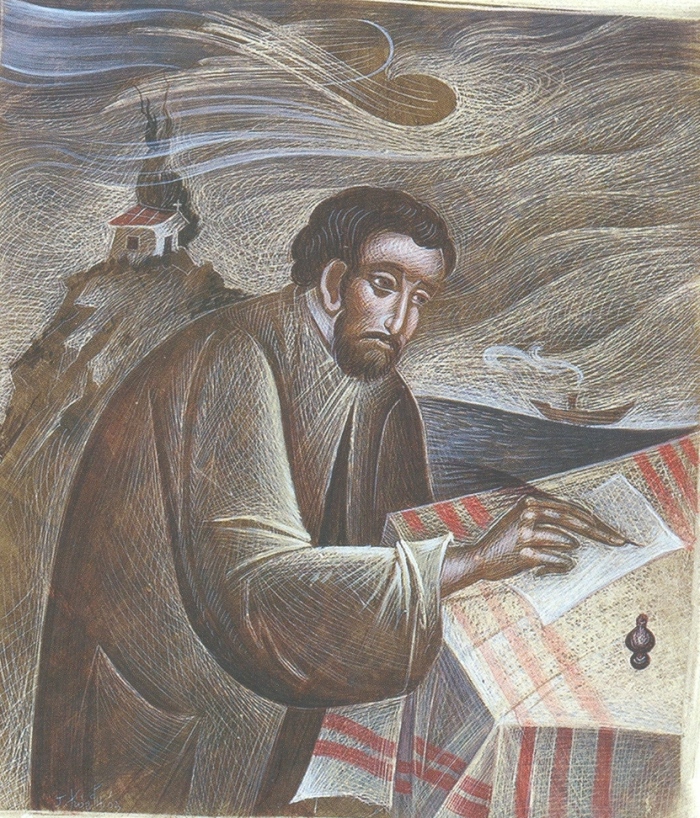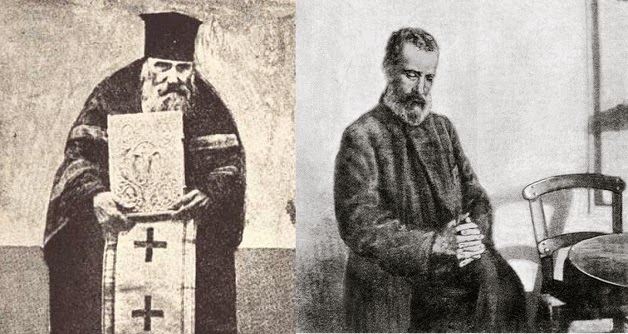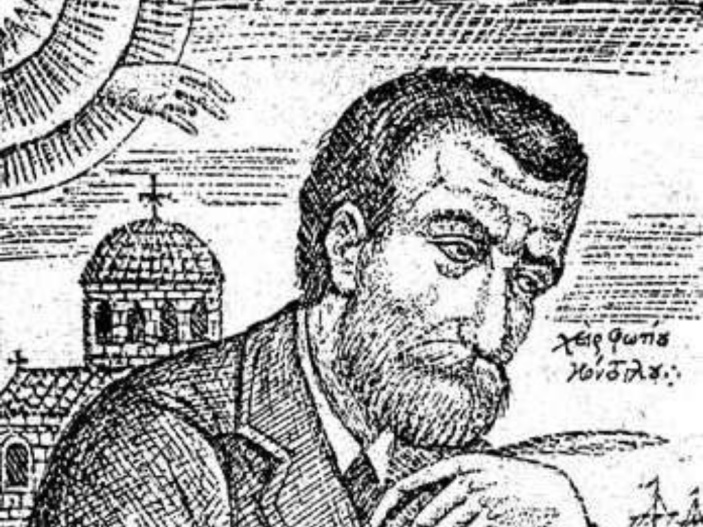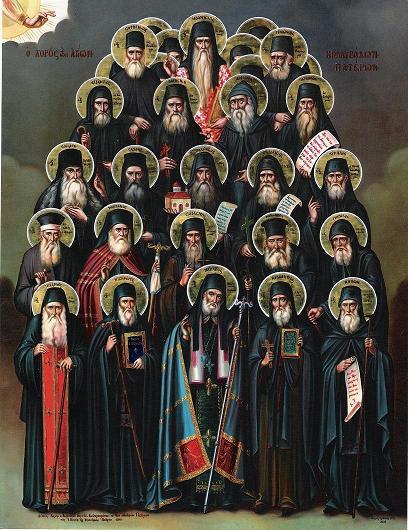
And a Charles Dickens too
Alexandros Papadiamandis was not a bishop. He was not priest. He was not a monk. He was a simple yet genuinely Orthodox layman who observed those who seized upon the great opportunity and those who failed to do so. His observations, in turn, became the heart of his fictional, but not fictitious, writings. As a layman and as an artist, he had the freedom to explore the great opportunity from every angle and the boldness to point out the obstacles to that opportunity, which are created when the misguided misunderstand the eucharistic and liturgical aspect of ecclesial life that makes that opportunity possible and act on that misunderstanding. … Papadiamandis’s profound understanding of what liturgy is and what liturgy can do enables Papadiamandis to initiate others through his writings into the mystery of this great opportunity. …
[For those in a hurry, you may skip the brief analysis, and go straight to his short story link at the bottom of the page]

… Papadiamandis opens another window by letting us see how the liturgy flowers, in all its manifestations, under the right conditions such as those that were present on his native island of Skiathos, and how it withers when fallen human interests deprive it of its proper soil and care. What makes this vision of Papadiamandis so compelling is that he does not merely offer us another philosophy of the liturgy or a new ideology for conservative or liberal reform. Instead, he offers us human examples taken from the experience of day-to-day life in Christ. His priests and lay folk are people with whom we can identify and to whom we can turn for guidance as we enter the same struggle to offer God the worship He is due.
Non-Orthodox readers might well be mystified by the importance of hymnography, architecture, iconography, and ecclesiastical music as sources of life and wisdom for Papadiamandis. They may be tempted to view Papadiamandis as a mystic or, even worse, as a religious fanatic.Such a view would greatly diminish the value of Papadiamandis’s observations and could not be further from the truth. Papadiamandis was a normal, healthy Orthodox Christian. He was a realist and, one could say, an empiricist. By experience, he knew the transfiguring power of the ecclesiastical arts in the Orthodox Church, and the wisdom he gained therefrom entered his fiction in a most natural way.

St. Nikolaos Planas and Papadiamandis
… Art is used to instruct the believer in a concrete Orthodox Christian approach to life in its manifold dimensions. The modern term for this ancient teaching technique would be the “multimedia experience,” with visual, musical, linguistic, and even olfactory dimensions. Each sense receives impressions that direct the entire soul to glorify God and repent for its own estrangement from the divine beauty that envelopes the soul during divine worship. Art is used not merely to educate the mind but, more importantly, to shape the heart and redirect its desires and ambitions.
In other words, the liturgical arts are the time-tested tools that the Church uses to heal the faithful and direct them to Christ. In Orthodoxy, the arts are not intended to provide religious entertainment for the senses but to purify them. The theological essence of Orthodoxy is quite precise, and the forms that protect the essence are necessarily precise as well. Those who attained to union with Christ either produced the liturgical arts or affirmed the fact that their use helps lead others to that same union. These artistic creations are the precious fruits of life in the Holy Spirit that lead those willing to be led to the spiritual life of Paradise. They have the purpose not only of opening the heavenly world of God’s glory to the believer, but also of opening up the believer’s own inner world so that he can see his passions and deceitful desires and, by God’s grace, defeat them.

One hymn in the veritable sea of liturgical texts has the faithful chant (and thus confess), “many times when I am chanting hymns I am also committing sins; for while my mouth utters songs of praise, my soul is pondering unseemly things.”Even the modern psychologist would agree that this brutal honesty about our fallenness and recognition of our hypocrisy is the first step to overcoming them both.
Another aspect of Papadiamandis’s vision that may seem strange in the West is the absolute centrality of the Church as experience. The liturgical life consists of more than a Protestant Sunday worship service or even a Roman Catholic daily mass. It is the oxygen that infuses the atmosphere of the believer’s entire life, enabling him to breathe. The texts from the divine services are what help him make basic decisions in his daily dealings with others. The liturgical life gives meaning to the most basic aspect of created life – time, the coming of day in Matins and the coming of night at Vespers. Simultaneously, it takes the believer beyond time in the Divine Liturgy to the uncreated reality of the glory of the Holy Trinity. Each day in the liturgical cycle is a unique gift of God, a unique opportunity to approach Him in thanksgiving and repentance. This is also reflected by the central icon of the Saint whose memory is celebrated on any particular day as well as by the liturgical texts that change with the hour, the day, and the season.

In the Orthodox Church, worship is a source of joyful sadness that clears the mind and heart with a sober optimism. It is also a real struggle of body and soul. This athletic aspect of Orthodox liturgical life may also perplex the non-Orthodox reader. Although the importance of pilgrimage is a common theme in the religious texts of Western Christendom, the importance of vigils, which are also associated with pilgrimage, may not be so readily apparent. Vigils enable the believer to give his entire self over to the liturgical life of the Church for an extended period of time. The night hours during which visibility is lessened, enable the believer to focus on turning inward. By devoting these hours of darkness to prayer, although they are the customary time for sleep, the believer offers a small sacrifice to God. In spite of the real struggles a vigil requires, the believer who turns to God for such an extended period of time does not feel as though he is offering God anything of particular significance, but that he is the fortunate recipient of mercy from God. The many blessed hours at prayer humble the soul, soften it, make it less selfish, and thus open it up to the grace of the Holy Spirit. There is nothing gloomy about these vigils. They are illumined by another light and quite naturally become a source of great joy; for, through such vigils, man can find his true self by finding the God of his heart.

Kollyvades Fathers
… What makes Papadiamandis’s treatment of religious themes unique, apart from the use of the modern novel and short story as a medium, is that his vision is formed by the truly praiseworthy, though much-maligned, Kollyvades fathers. These modern fathers, devoted to the tradition of the Philokalia, refused to separate liturgical practice from dogma and spiritual endeavor for the sake of secondary expediencies of convenience or practicality. They understood that the true goal of liturgy, dogma, and spiritual endeavor is union with Christ. All the details in the rich tapestry of Orthodoxy must serve that goal, or they fray into an incoherent tangled mass of strands leading nowhere at all. The Kollyvades fathers were Papadiamandis’s teachers, and by experience he knew the benefits of following their guidance. …
For Papadiamandis, the way the divine services are conducted and the texts and actions called for by these services form a unity. In particular, humility rather than ostentation is the guide for how the priest should serve, how the chanters should chant, and how the Church should be adorned. This humility is not a forced posturing but the natural outcome of serving the Eucharist with awareness that Christ is the One offering and being offered. … the point of Papadiamandis’s narratives is that the downtrodden, wounded, and despised can be transfigured into the glorious people of God through the Church’s divine worship.
… Humility in liturgical celebrations enables the priest to be shepherded with his flock by Christ, the One True Shepherd. Humility enables the priest to console the suffering. Humility encourages the priest to be dedicated to the divine services and to celebrate them with the fear of God and precision [akriveia]. This precision and fear of God in serving the services as the typicon and sacred canons prescribe, in turn, sanctify the priest, crowning him with the wisdom and understanding needed to be a good physician to the souls under his care.
… A long-hidden literary treasure of Orthodox Greece, the early twentieth-century writer Alexandros Papadiamandis has often been called “the Greek Dostoevsky.” Like his Russian counterpart, Papadiamandis gave a realistic view of contemporary lives nourished with the rich springs of Orthodox spirituality. However, Alexandros Papadiamandis may not only be considered a “Dostoevsky of Modern Greece”, but one can argue, he is a “Charles Dickens of Modern Greece” as well.
“The main difference between the two great writers is, apart from the fact that Dicken’s childhood was much more painful than Papadiamandis’, that while Dickens got married, had a big family, made a fortune out of his writing, won high praise by his contemporaries on both sides of the Atlantic and enjoyed publicity, Papadiamandis remained a single, lonely, poor man, despised by most of his peers and avoided being in the public eye at all costs.” (*)
“The closest parallel to Papadiamandis’s short stories and novels is found in large sections of Fyodor Dostoevsky’s The Brothers Karamazov, which are likewise saturated with Orthodox teaching taken, in many instances, from texts read during the liturgical services. … Like Dostoevsky, Papadiamandis looked deep into the human soul and found that its beauty and nobility depend not on the power of its intellect, or on the intensity of its desire, but on its genuine relationship with God.”.
*
To read the full article “Greece’s Dostoevsky: The Theological Vision of Alexandros Papadiamandis, A Unique Witness to a Unique Opportunity”, The Foreword by Hieromonk Alexis (Trader), The Sacred Monastery of Karakallou, The Holy Mountain of Athos, go to: http://orthodoxinfo.com/phronema/greeces-dostoevsky-the-theological-vision-of-alexandros-papadiamandis.aspx
*
For more insights, read Dr. Andrew Herman Middleton’s interview of Dr. Anestis Keselopoulos, professor of Ethics, Pastoral Theology and Orthodox Spiritual Life at the Aristotle University of Thessaloniki, and author of Greece’s Dostoevsky: The Theological Vision of Alexandros Papadiamandis at http://www.roadtoemmaus.net/back_issue_articles/RTE_34/Greeces_Dostoevsky.pdf
*
(*) Mystagogy, The Weblog of John Sanidopoulos. http://www.johnsanidopoulos.com/2009/12/gleaner-christmas-story-by.html
*
Alexandros Papadiamantis’ work is seminal in Modern Greek literature. … It is a body of work, however, that is virtually impossible to translate, as the magic of his language is founded on the Greek diglossia: elaborately crafted, high Katharevousa for the narrative, interspersed with authentic local dialect for the dialogue, and with all dialectical elements used in the narrative formulated in strict Katharevousa, and therefore in forms that had never actually existed.
Unfortunately not many of his stories are online, but I found one titled “A Village Easter”, Memories of Childhood at http://www.roadtoemmaus.net/back_issue_articles/RTE_34/A_Village_Easter.pdf
